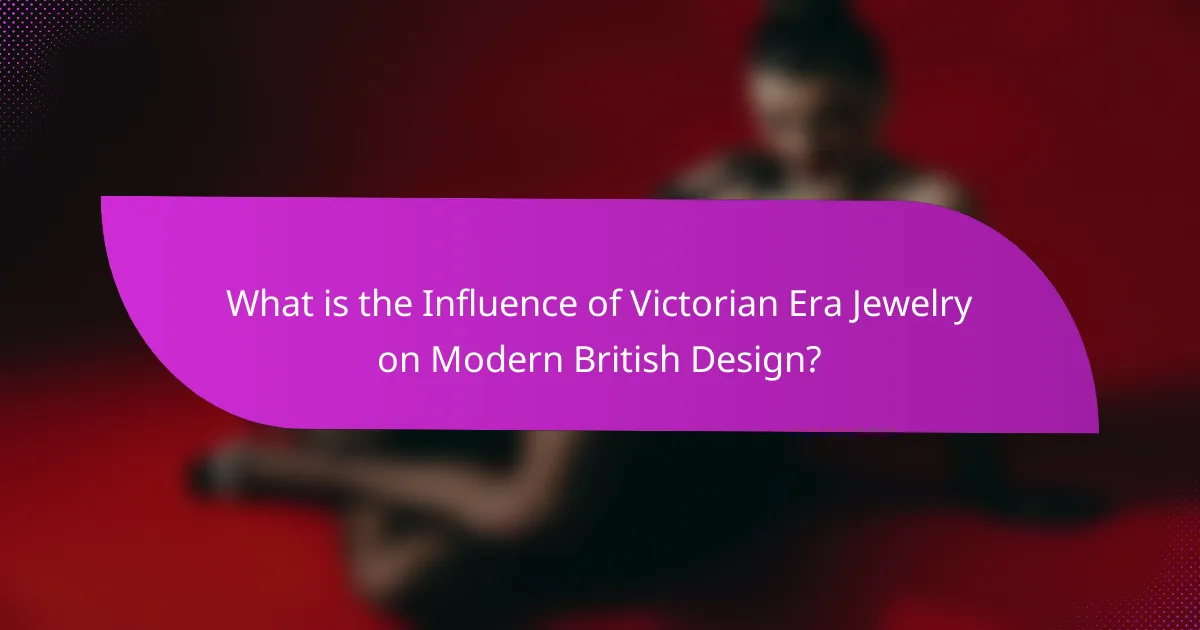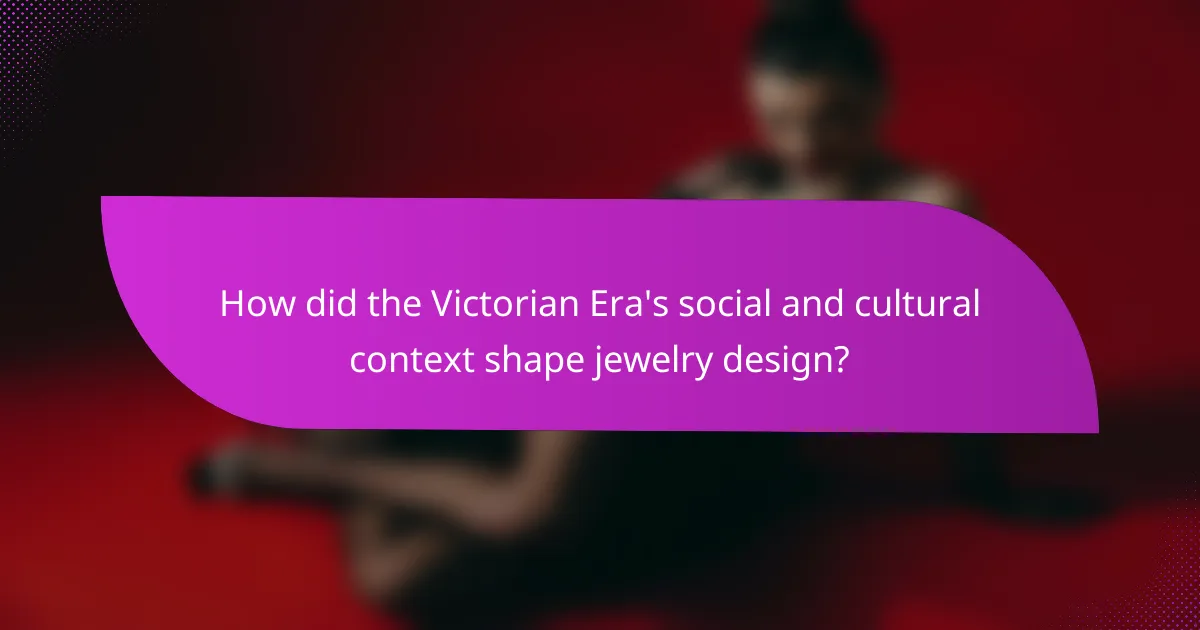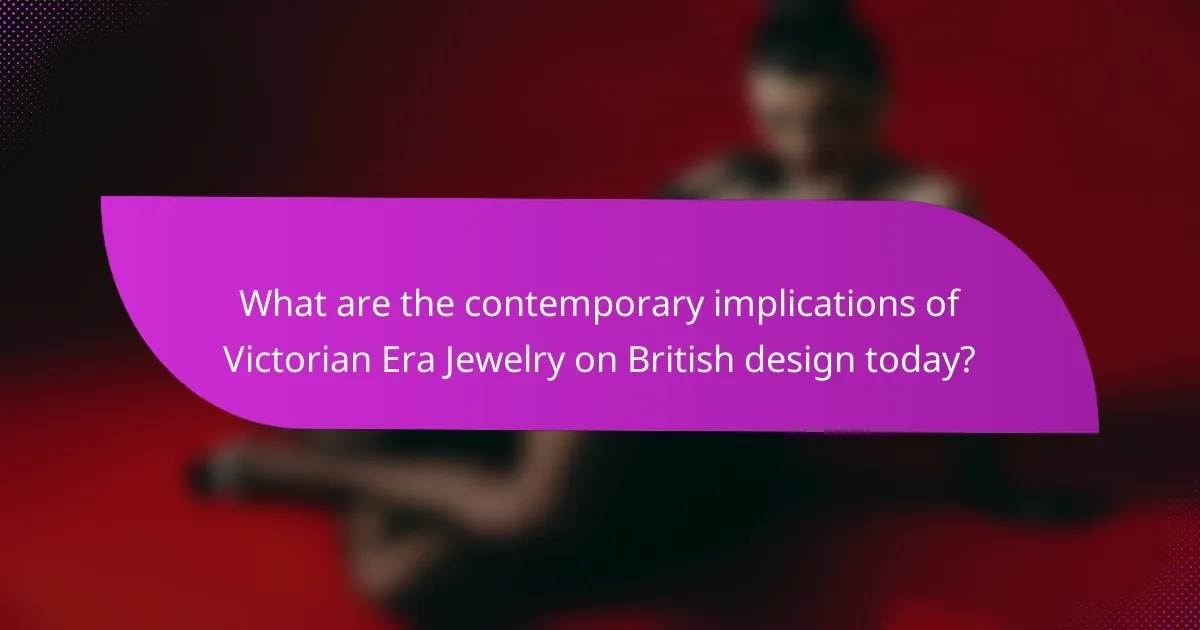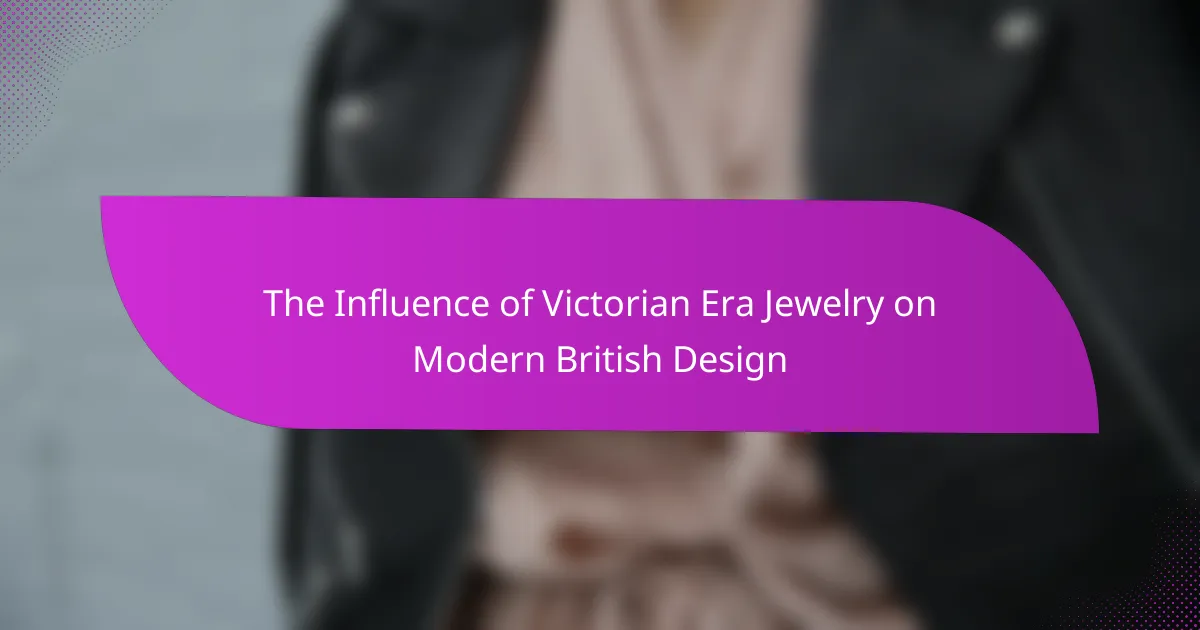Victorian Era jewelry, spanning from 1837 to 1901, plays a significant role in shaping modern British jewelry design. The era is characterized by intricate craftsmanship, floral motifs, and symbolism, which continue to inspire contemporary jewelers. Key elements such as the use of gold and gemstones, along with a focus on personalization and sentimental value, reflect the enduring legacy of Victorian aesthetics. Additionally, the rise of middle-class consumers during the Industrial Revolution led to a demand for ornate pieces, further influencing modern designs. This article explores how these historical influences manifest in today’s jewelry collections, highlighting the connection between past and present in British design.

What is the Influence of Victorian Era Jewelry on Modern British Design?
Victorian Era jewelry significantly influences modern British design. The intricate craftsmanship and romantic motifs of the Victorian period inspire contemporary jewelers. Elements such as floral designs and symbolism are prevalent in today’s creations. Additionally, the use of materials like gold and gemstones remains popular. Victorian revival styles often appear in modern collections, reflecting nostalgia for the past. The emphasis on personalization and sentimental value is also a key influence. Modern designers frequently draw from Victorian themes to create unique pieces. This connection highlights the enduring legacy of Victorian aesthetics in British jewelry design.
How did Victorian Era Jewelry reflect the culture of its time?
Victorian Era jewelry reflected the culture of its time through intricate designs and symbolic meanings. The jewelry often featured motifs such as flowers, hearts, and mourning symbols. These designs were influenced by the Romantic movement, emphasizing emotion and nature. Additionally, the use of materials like gold, silver, and gemstones showcased wealth and social status. During the Victorian period, jewelry also served as a form of communication, conveying messages of love, loss, and social connections. The popularity of sentimental jewelry, such as lockets and brooches, highlighted personal relationships and memories. Overall, Victorian jewelry was a mirror of societal values, aesthetics, and emotional expressions of the era.
What were the key characteristics of Victorian Era Jewelry?
Victorian Era jewelry is characterized by intricate designs, symbolism, and diverse materials. The period spanned from 1837 to 1901, coinciding with Queen Victoria’s reign. Jewelry from this era often featured motifs like flowers, leaves, and animals, reflecting nature’s influence. The use of gemstones was prevalent, with popular choices including diamonds, pearls, and colored stones.
Additionally, the craftsmanship was exceptional, showcasing techniques like engraving and enameling. Mourning jewelry became significant during this time, often incorporating hair or images of the deceased. The designs varied across the Victorian period, transitioning from romantic styles to more elaborate and ornate pieces. This evolution mirrored societal changes and technological advancements in jewelry making.
How did societal changes influence the design of Victorian Jewelry?
Societal changes significantly influenced the design of Victorian jewelry. The Industrial Revolution led to mass production, allowing for more intricate designs at lower costs. This accessibility shifted jewelry from exclusive luxury to a more widely available adornment. The rise of the middle class also impacted styles, as they sought to express their newfound wealth. Sentimental motifs became popular, reflecting personal connections and family ties. Additionally, changing social norms, including women’s rights movements, influenced designs to be more feminine and ornate. The fascination with nature during this era inspired the use of floral and naturalistic themes in jewelry. Overall, these societal shifts shaped the aesthetics and accessibility of Victorian jewelry.
Why is Victorian Era Jewelry significant in the context of modern design?
Victorian Era Jewelry is significant in modern design due to its intricate craftsmanship and symbolic meanings. The era emphasized personalization and storytelling through jewelry. This focus has influenced contemporary designers to create pieces that convey individual narratives. Additionally, the use of diverse materials and techniques in Victorian jewelry has inspired modern artisans. For instance, the revival of antique styles reflects a growing appreciation for historical aesthetics. The Victorian emphasis on sentimentality also resonates in today’s custom jewelry market. Overall, Victorian jewelry continues to shape modern design by blending tradition with innovation.
What elements from Victorian design are still present in modern jewelry?
Victorian design elements still present in modern jewelry include intricate detailing, floral motifs, and the use of gemstones. Intricate detailing was a hallmark of Victorian jewelry, showcasing craftsmanship that remains valued today. Floral motifs, inspired by nature, continue to influence contemporary designs. The use of gemstones, particularly opals and pearls, reflects Victorian preferences and persists in modern pieces. Additionally, the sentimental value of lockets and cameos, popular in the Victorian era, is still cherished in today’s jewelry. These elements demonstrate the lasting impact of Victorian aesthetics on current jewelry trends.
How has the interpretation of Victorian designs evolved in contemporary pieces?
Contemporary pieces have evolved to reinterpret Victorian designs by blending historical elements with modern aesthetics. Designers often incorporate Victorian motifs such as intricate filigree and floral patterns. These motifs are simplified for a cleaner, more minimalist look. Additionally, modern materials like resin and stainless steel are used alongside traditional metals. This shift allows for innovative forms and functions while maintaining a connection to the past. The use of color and texture has also diversified, moving away from the typical gold and silver to include vibrant hues. This evolution reflects a broader trend of nostalgia in design, where historical influences are reimagined for contemporary tastes.
What are the main styles of Victorian Era Jewelry that influenced modern design?
The main styles of Victorian Era jewelry that influenced modern design include Romantic, Aesthetic, and Arts and Crafts styles. Romantic jewelry featured intricate designs with motifs such as flowers and hearts. It emphasized sentimental value and personal expression. Aesthetic jewelry focused on beauty and artistic expression, often incorporating natural themes. It aimed to elevate the decorative arts. Arts and Crafts jewelry emphasized craftsmanship and simplicity. It rejected mass production in favor of handmade quality. These styles have left a lasting impact on contemporary jewelry design, inspiring modern artisans to blend craftsmanship with artistic expression.
What role did materials play in Victorian jewelry styles?
Materials were fundamental in defining Victorian jewelry styles. The era saw the use of diverse materials, including gold, silver, and various gemstones. Gold was favored for its durability and luster, often used in intricate designs. Silver provided a more affordable option, allowing for elaborate pieces at lower costs. Gemstones such as diamonds, pearls, and garnets were popular, each symbolizing different meanings and statuses.
Victorian jewelry also embraced materials like enamel and ivory, enhancing color and texture. The use of materials reflected societal changes and technological advancements, such as improved mining techniques. Additionally, the influence of nature was evident, with materials often mimicking floral and organic forms. Overall, materials played a crucial role in shaping the aesthetics and symbolism of Victorian jewelry, influencing modern British design significantly.
How did symbolism in Victorian jewelry impact modern interpretations?
Symbolism in Victorian jewelry significantly influences modern interpretations. Victorian jewelry often featured motifs like hearts, locks, and flowers, representing love, secrecy, and nature. These motifs have been reinterpreted in contemporary designs, emphasizing emotional connections. Modern jewelers draw inspiration from Victorian symbolism to create pieces that convey personal stories. For instance, heart-shaped pendants are popular today, echoing the Victorian emphasis on romantic symbolism. The use of intricate designs and meaningful symbols continues to resonate with consumers seeking personal significance in their jewelry. This connection between past and present highlights the lasting impact of Victorian symbolism on modern jewelry design.

How did the Victorian Era’s social and cultural context shape jewelry design?
The Victorian Era’s social and cultural context significantly influenced jewelry design. This period, spanning from 1837 to 1901, was marked by strict social hierarchies and significant technological advancements. Jewelry became a reflection of personal identity and social status.
The Industrial Revolution enabled mass production, making jewelry more accessible. This led to the rise of middle-class consumers who desired ornate pieces. Additionally, the era’s fascination with nature inspired designs featuring floral motifs and intricate craftsmanship.
Sentimental jewelry became popular, often incorporating lockets and hair work to symbolize love and remembrance. The use of gemstones, such as diamonds and pearls, was prevalent, symbolizing wealth and prestige.
Cultural movements, like the Gothic Revival, also influenced design, leading to the incorporation of medieval elements. Overall, the Victorian Era’s complex social dynamics and cultural interests shaped a diverse and rich jewelry design landscape.
What were the major social influences on Victorian jewelry design?
Victorian jewelry design was significantly influenced by social changes during the 19th century. The Industrial Revolution led to increased production capabilities and access to materials. This period also saw the rise of the middle class, which expanded consumer demand for jewelry. Furthermore, the Victorian era was marked by strict social codes and romantic ideals. These ideals influenced the choice of motifs, such as flowers and hearts, in jewelry design. The mourning culture also played a crucial role, with pieces made from jet and hair being popular. Additionally, the revival of interest in historical styles, like Gothic and Renaissance, impacted design aesthetics. Overall, social dynamics, economic factors, and cultural trends shaped Victorian jewelry.
How did class distinctions affect jewelry styles and materials?
Class distinctions significantly affected jewelry styles and materials during the Victorian era. The upper class often wore extravagant pieces made from precious metals and gemstones. These items showcased intricate craftsmanship and were symbols of wealth and status. In contrast, the middle and lower classes typically used less expensive materials. They favored simpler designs, often made from base metals and glass.
The use of materials reflected societal status. For example, gold and diamonds were exclusive to the affluent. Meanwhile, silver and semi-precious stones were more common among the middle class. The designs also varied; elaborate motifs characterized upper-class jewelry, while more practical and modest styles defined lower-class pieces.
Historical context supports these distinctions. The Industrial Revolution led to mass production, making jewelry more accessible. However, the quality and design still varied greatly by class. This divide in styles and materials laid the groundwork for modern interpretations of jewelry design in Britain.
What impact did technological advancements have on jewelry production during the Victorian Era?
Technological advancements significantly enhanced jewelry production during the Victorian Era. Innovations such as the steam engine and improved metalworking techniques increased efficiency. Mass production became possible, allowing for greater availability of jewelry. The introduction of electroplating made it feasible to create affordable pieces that mimicked precious metals. Additionally, advances in gemstone cutting improved the quality and brilliance of stones used in jewelry. These developments expanded consumer access to jewelry, making it a popular accessory for various social classes. The Victorian Era thus marked a pivotal shift in jewelry production, blending artistry with industrial efficiency.
How did the Victorian Era’s artistic movements influence jewelry design?
The Victorian Era’s artistic movements significantly influenced jewelry design through elaborate styles and symbolic motifs. The Romantic movement emphasized emotion and nature, leading to the use of organic forms and floral designs in jewelry. The Arts and Crafts movement prioritized craftsmanship and natural materials, resulting in unique, handmade pieces that celebrated individuality. Additionally, the Aesthetic movement introduced the idea of beauty for beauty’s sake, inspiring intricate detailing and artistic expressions in jewelry. These movements collectively shaped the aesthetic values of the time, making jewelry a reflection of personal identity and artistic expression. This period also saw the incorporation of new materials, such as gold and gemstones, further enhancing the diversity in design. The impact of these artistic movements is still evident in modern British jewelry design, which often draws inspiration from Victorian aesthetics.
What role did the Arts and Crafts movement play in shaping jewelry aesthetics?
The Arts and Crafts movement significantly influenced jewelry aesthetics by emphasizing craftsmanship and natural forms. This movement emerged in the late 19th century as a reaction against industrialization. Artisans prioritized handmade techniques over mass production. They drew inspiration from nature, using organic shapes and motifs in their designs. Materials were often chosen for their beauty and intrinsic qualities. This approach led to unique and personalized pieces, contrasting with the ornate styles of the Victorian era. Notable figures, such as William Morris, championed these ideals, advocating for a return to traditional craftsmanship. The legacy of the Arts and Crafts movement continues to impact modern jewelry design, promoting a focus on artistry and individuality.
How did Gothic Revival architecture influence jewelry motifs?
Gothic Revival architecture significantly influenced jewelry motifs during the Victorian Era. The architectural style emphasized intricate details and ornate designs. Jewelry from this period often mirrored these characteristics. Elements such as pointed arches and tracery were reflected in the shapes of pendants and brooches. Additionally, the use of materials like enamel and gemstones became prevalent, echoing the vibrant colors of Gothic stained glass. Jewelry designers sought to evoke the grandeur of cathedrals in their creations. This connection between architecture and jewelry is evident in pieces that feature gothic elements, such as gargoyles or floral patterns. The influence of Gothic Revival architecture remains a defining aspect of Victorian jewelry design.

What are the contemporary implications of Victorian Era Jewelry on British design today?
Contemporary British design is significantly influenced by Victorian Era jewelry. Elements such as intricate detailing, symbolism, and craftsmanship are prevalent in modern jewelry. Designers often draw inspiration from Victorian motifs like floral patterns and geometric shapes. The use of materials like gold and silver remains popular, reflecting Victorian aesthetics. Additionally, the concept of sentimental jewelry has resurged, mirroring Victorian practices. Modern pieces often incorporate personalization, akin to Victorian lockets and keepsakes. This revival of Victorian styles showcases a blend of historical appreciation and contemporary innovation in British design.
How do modern designers incorporate Victorian elements into their work?
Modern designers incorporate Victorian elements into their work through the use of intricate patterns and ornate detailing. They often draw inspiration from Victorian motifs such as floral designs and geometric shapes. These elements are integrated into contemporary jewelry pieces, textiles, and furniture. Designers may utilize materials like brass, silver, and gemstones reminiscent of the Victorian era. Color palettes often reflect the rich hues popular during that time, including deep reds, greens, and blues. Additionally, modern designers may incorporate Victorian craftsmanship techniques, such as engraving and filigree work. This blend of old and new creates a unique aesthetic that honors historical influences while appealing to modern tastes.
What are some examples of modern jewelry brands inspired by Victorian design?
Some examples of modern jewelry brands inspired by Victorian design include Alex Monroe, The Vintage Ring Company, and Boodles. Alex Monroe specializes in nature-inspired pieces that reflect Victorian aesthetics. The Vintage Ring Company offers antique and vintage-style rings with intricate details. Boodles incorporates classic Victorian motifs into contemporary jewelry designs. These brands showcase how Victorian influences remain relevant in today’s jewelry market.
How do consumer preferences for vintage styles influence contemporary jewelry trends?
Consumer preferences for vintage styles significantly shape contemporary jewelry trends. Many consumers are drawn to the aesthetics and craftsmanship of vintage designs. This desire drives modern jewelers to incorporate vintage elements into their collections. For example, the resurgence of Art Deco motifs can be seen in recent jewelry lines. Vintage styles often emphasize intricate detailing and unique gemstones. This contrasts with the minimalist trends that dominated previous years. Research indicates that over 60% of consumers prefer jewelry that reflects historical styles. Additionally, vintage-inspired pieces often command higher prices, reflecting their desirability. Thus, consumer interest in vintage styles directly influences the design choices of contemporary jewelers.
What lessons can modern designers learn from Victorian Era Jewelry?
Modern designers can learn several lessons from Victorian Era jewelry. One key lesson is the importance of intricate craftsmanship. Victorian jewelry was characterized by detailed designs and skilled artistry. This emphasis on craftsmanship can inspire modern designers to prioritize quality and attention to detail in their work.
Another lesson is the use of symbolism in jewelry design. Victorian pieces often featured motifs representing love, mourning, or nature. Incorporating meaningful symbols can add depth and storytelling to contemporary designs.
Additionally, the Victorian era showcased a blend of materials, such as gold, silver, and gemstones. This variety encourages modern designers to experiment with mixed materials for unique and innovative pieces.
Finally, the popularity of personalization in Victorian jewelry, like lockets and monograms, highlights the value of customization. Modern designers can benefit from offering personalized options to consumers, enhancing emotional connections to their creations.
How can the craftsmanship of Victorian jewelry inform today’s design practices?
The craftsmanship of Victorian jewelry can inform today’s design practices by emphasizing intricate detailing and craftsmanship. Victorian jewelry is characterized by its elaborate designs and use of materials like gold, silver, and gemstones. This focus on quality and artistry can inspire modern designers to prioritize craftsmanship in their work.
Additionally, the Victorian era featured a variety of styles, such as sentimental jewelry and nature-inspired motifs. These themes can encourage contemporary designers to explore personal narratives and natural elements in their creations.
Moreover, Victorian jewelry often incorporated innovative techniques, such as enameling and gemstone cutting. Learning from these methods can enhance modern design approaches. The historical significance and aesthetic appeal of Victorian jewelry serve as a rich source of inspiration for today’s designers, promoting a revival of traditional techniques and a deeper appreciation for craftsmanship.
What are the best practices for blending Victorian elements with modern aesthetics?
To blend Victorian elements with modern aesthetics, focus on key design principles. Start by selecting a color palette that combines rich Victorian hues with contemporary neutrals. Incorporate Victorian motifs, such as floral patterns or intricate filigree, but simplify them for a modern look. Use materials that reflect both eras, like combining antique metals with sleek glass or acrylic. Balance ornate Victorian details with minimalist modern lines to create harmony. Furniture and decor should feature Victorian shapes but use modern finishes. Consider scale; larger Victorian pieces can be paired with smaller, modern elements to avoid overwhelming spaces. This approach maintains the charm of Victorian design while ensuring functionality and relevance in contemporary settings.
The main entity of the article is Victorian Era jewelry and its influence on modern British design. The article explores how the intricate craftsmanship, romantic motifs, and symbolic meanings of Victorian jewelry continue to inspire contemporary designers. It highlights key characteristics of Victorian jewelry, including its reflection of societal values and the impact of technological advancements on production. Additionally, the article discusses how modern interpretations incorporate Victorian elements while addressing consumer preferences for vintage styles, emphasizing the enduring legacy and relevance of Victorian aesthetics in today’s jewelry market.
